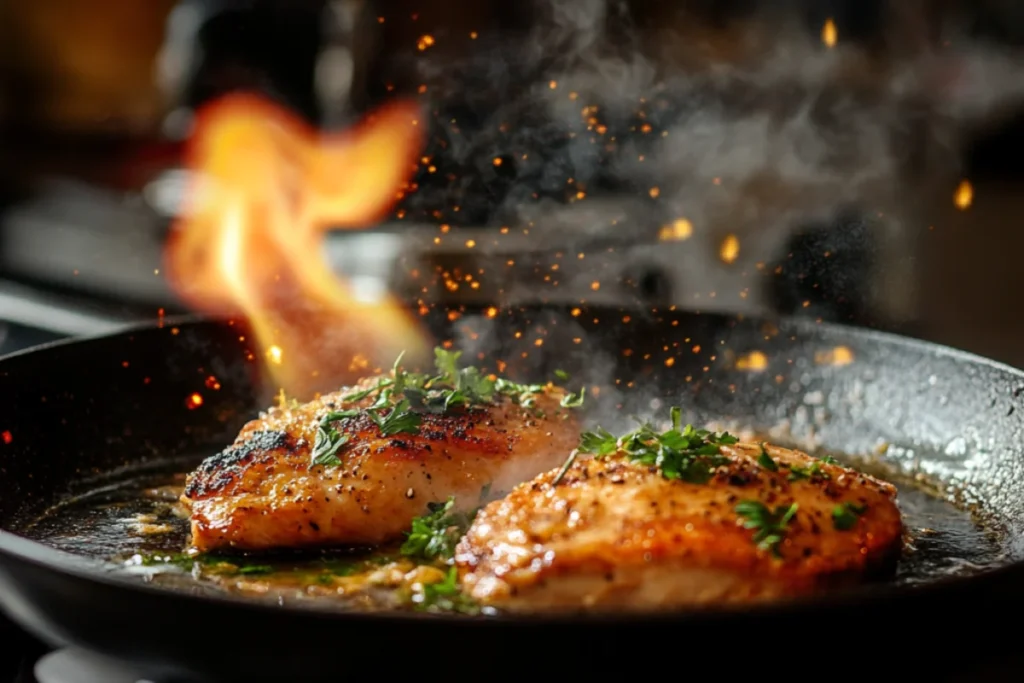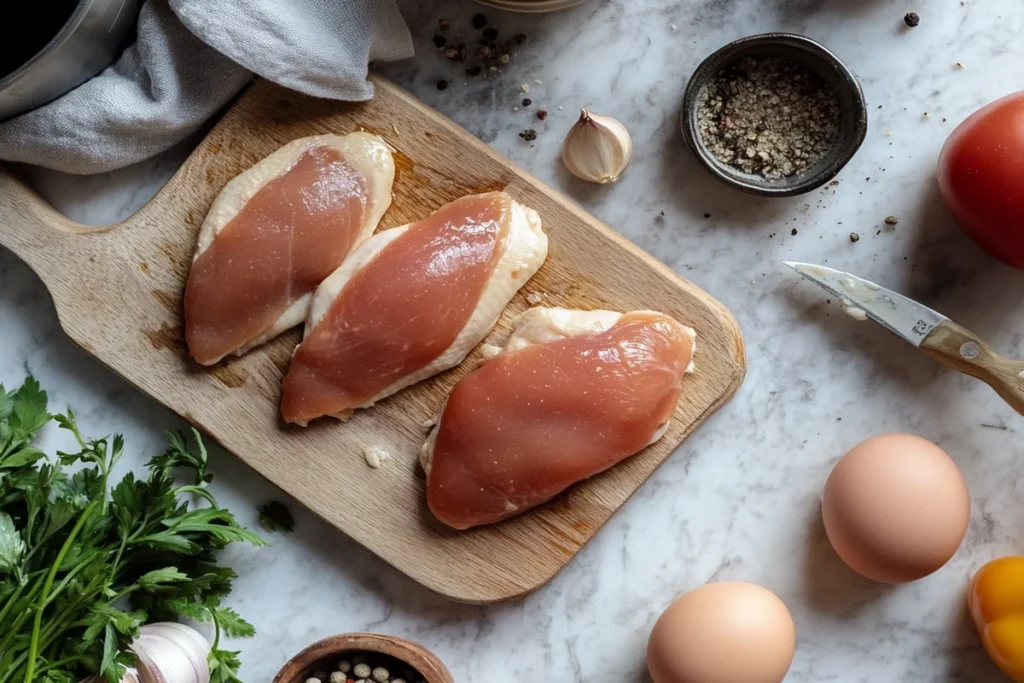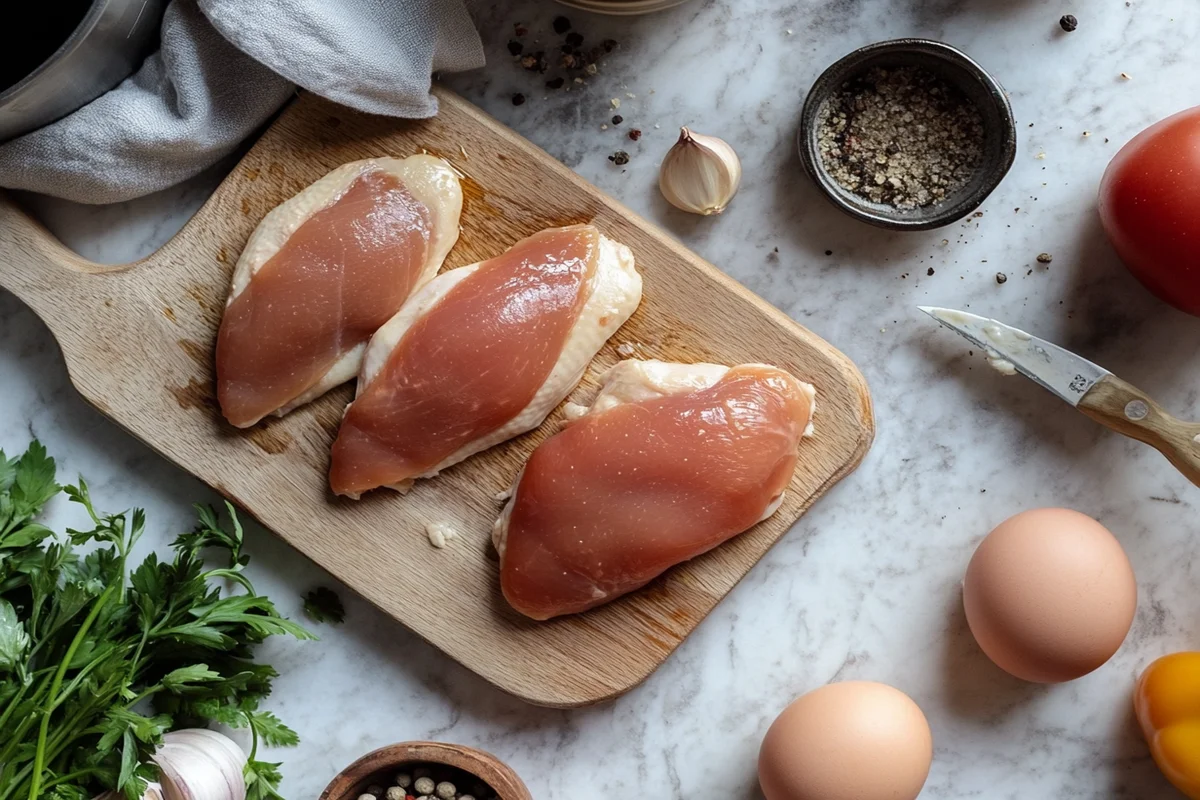
How to Flatten and Stuff Chicken Breast: Step-by-Step Guide
Introduction
Mastering the art of flattening and stuffing chicken breasts is a game-changer for home cooks! This culinary technique doesn’t just make your chicken cook evenly but also creates a perfect canvas for mouthwatering fillings. Imagine juicy, flavorful chicken paired with cheesy, herby, or even veggie-packed surprises inside—what a treat! In this comprehensive guide, we’ll walk through everything you need to know, from preparation to cooking methods, ensuring your stuffed chicken breast turns out perfect every single time. Let’s dive in, starting with the basics.
Part 1: Understanding the Art of Flattening and Stuffing Chicken Breasts
Importance of Flattening Chicken Breasts
Flattening chicken breasts might sound like an extra step, but oh, it’s worth it! For one, it ensures that your chicken cooks evenly. Unevenly thick chicken can result in dry edges while the middle stays undercooked—not exactly appetizing. When you flatten it, you create a uniform surface, guaranteeing that every bite is cooked to perfection.
Even more importantly, a flat chicken breast absorbs marinades and seasonings better, allowing all the flavors to penetrate. Imagine marinating your chicken in a zesty garlic-herb mixture and knowing every bit of meat will taste divine. Plus, flattening makes stuffing simpler by giving you more surface area to work with.
Benefits of Stuffing Chicken Breasts
Stuffed chicken breasts don’t just look impressive; they taste phenomenal. Why? The stuffing introduces layers of flavor and texture you wouldn’t otherwise get. For instance, a gooey blend of cheese, spinach, and herbs inside the chicken creates a delightful contrast to its savory exterior.
Besides, stuffing allows you to get creative. Have leftover vegetables? Dice them up and mix them with some shredded chicken or cheese for a filling. The possibilities are endless. And it’s not just about flavor; stuffed chicken breasts can be healthier too. Instead of frying or breading, baking or grilling stuffed chicken locks in moisture while keeping calories in check.
Now that we’ve laid the groundwork, let’s move on to preparing your chicken for this flavorful journey!
Part 2: Preparing to Flatten and Stuff Chicken Breasts
Essential Tools and Ingredients
Before embarking on the journey to flatten and stuff chicken breasts, gathering the right tools and ingredients is crucial. A well-prepared workstation makes the process not only smoother but also more enjoyable. Here’s what you’ll need.
Tools Needed
- Meat Mallet or Rolling Pin
A meat mallet is your best friend for flattening chicken. With its textured surface, it evenly thins the meat without tearing it. No mallet? No problem—grab a rolling pin! Though not as effective as a mallet, it still gets the job done if used carefully. - Sharp Knife
Precision is key when creating a pocket for the stuffing. A dull knife could tear the chicken, ruining the structure and making it harder to keep the filling inside. - Cutting Board
Choose a sturdy, large cutting board to give yourself enough space to work. A non-slip board is preferable for safety while cutting. - Plastic Wrap or Parchment Paper
Place your chicken between two sheets of plastic wrap or parchment paper before flattening. This keeps your tools clean and prevents the chicken from sticking or tearing during the process.
Choosing the Right Chicken Breasts
Not all chicken breasts are created equal! To achieve the best results, you’ll need to be selective.
- Boneless, Skinless Breasts
This type of chicken breast is perfect for stuffing. Bones and skin complicate the flattening process, so always opt for boneless, skinless pieces. Plus, they cook faster and more evenly. - Optimal Size and Thickness
Look for medium to large chicken breasts with an even thickness. A chicken breast that’s too small may not hold the stuffing well, while an overly thick one can be challenging to flatten. If the breast is very uneven, consider trimming it slightly before starting.
With your tools ready and chicken prepped, you’re all set to dive into the actual flattening process. Trust me, it’s easier than you think—and oh-so-satisfying! Ready to roll? Let’s move on to the next step.
Part 3: Step-by-Step Guide to Flattening Chicken Breasts

How to Flatten Chicken Breasts
Flattening chicken breasts might sound intimidating, but it’s incredibly straightforward once you know the steps. This process transforms uneven pieces into a uniform canvas, perfect for stuffing and cooking. Let’s break it down.
Preparing the Chicken
Before grabbing your mallet or rolling pin, a bit of prep work is essential to make the process seamless.
- Trimming Excess Fat
Inspect the chicken breast for any visible fat or cartilage. Use a sharp knife to trim these away, as they can interfere with the flattening process and affect the final texture of your dish. - Patting Dry
Moisture on the chicken’s surface can make it slippery and challenging to work with. Use a paper towel to gently pat the chicken dry, ensuring it stays in place while you flatten it.
Flattening Techniques
Once prepped, it’s time to get hands-on. Choose your preferred technique below.
- Using a Meat Mallet
Place the chicken breast between two sheets of plastic wrap or parchment paper to prevent tearing. Using the flat side of the mallet, start from the center of the breast and work outward. Apply firm but controlled pressure, making the meat as even as possible. - Alternative Methods (e.g., Rolling Pin)
No mallet? No worries. Use a rolling pin in much the same way. However, be gentler to avoid accidentally shredding the chicken. While this method takes a bit more time, the result is just as effective.
Flattening chicken breasts isn’t just practical—it’s also a little therapeutic! Once you’ve got the hang of it, you’ll wonder how you ever cooked without this technique. Next up, let’s take it a step further and explore how to add that delicious filling.
Part 4: Techniques for Stuffing Chicken Breasts

How to Stuff Chicken Breasts
Stuffing chicken breasts is where the magic happens. With your perfectly flattened chicken, it’s time to add the flavorful filling and turn a simple ingredient into a culinary masterpiece. Follow these steps to get it just right.
Creating a Pocket
The key to successfully stuffing a chicken breast lies in creating a secure pocket. It’s a straightforward process if you use the right tools and technique.
- Horizontal Cutting Method
Place the flattened chicken breast on a cutting board. Using a sharp knife, carefully cut a horizontal slit into the thickest side of the chicken, stopping about 1 inch from the other side. Be sure not to cut all the way through, as this will result in an open flap instead of a pocket. - Ensuring Even Thickness
While cutting, take your time to keep the pocket even. Uneven thickness can cause the filling to spill out during cooking. Rotate the chicken slightly if needed to maintain precision.
Selecting and Preparing Fillings
Now for the fun part—choosing your stuffing! This step allows you to customize flavors to match your preferences or the meal’s theme.
- Cheese and Herb Mixtures
Creamy cheeses like mozzarella, feta, or goat cheese pair beautifully with fresh herbs such as parsley, thyme, or dill. Mix them together with a touch of seasoning for a simple yet flavorful filling. - Vegetable and Protein Combinations
For a heartier option, combine sautéed spinach, diced mushrooms, or roasted red peppers with shredded chicken or cooked sausage. Add a sprinkle of seasoning, and you’ve got a filling that’s bursting with flavor and texture.
Pro Tip for Stuffing Success
To keep the filling inside the chicken during cooking, use toothpicks to seal the edges of the breast after stuffing. Simply slide the toothpicks through both sides of the opening to close it securely.
With the chicken stuffed and sealed, you’re just a step away from creating a mouthwatering dish. Next, we’ll dive into the best methods for cooking stuffed chicken breasts to ensure they turn out juicy and flavorful every time.
Part 5: Cooking Methods for Stuffed Chicken Breasts
Cooking Techniques
Cooking stuffed chicken breasts to perfection requires just the right balance of heat and timing. Done right, the chicken remains moist, and the filling stays intact. Here are two tried-and-true methods to ensure delicious results every time.
Baking Stuffed Chicken Breasts
Baking is one of the easiest and most reliable ways to cook stuffed chicken breasts. It allows the flavors of the stuffing to meld with the chicken while keeping the meat tender.
- Temperature and Timing
Preheat your oven to 375°F (190°C). Place the stuffed chicken breasts on a baking sheet lined with parchment paper. Bake for 25–30 minutes, or until the internal temperature reaches 165°F (74°C). Using a meat thermometer is critical here—no one wants undercooked chicken! - Ensuring Juiciness
Brush the chicken lightly with olive oil before baking. This not only enhances the flavor but also prevents the chicken from drying out. You can also tent the chicken with foil for the first 15 minutes to lock in moisture.
Grilling Stuffed Chicken Breasts
Grilling adds a smoky depth of flavor that complements the stuffing beautifully. It’s a slightly more hands-on method but well worth the effort.
- Preparing the Grill
Preheat your grill to medium heat and lightly oil the grates to prevent sticking. If you’re using charcoal, ensure the coals are evenly distributed for consistent heat. - Achieving Grill Marks and Doneness
Place the stuffed chicken breasts on the grill and cook for about 6–8 minutes per side. Check for doneness by ensuring the internal temperature reaches 165°F (74°C). Rotate the chicken slightly halfway through cooking each side to achieve those coveted grill marks.
A Note on Cooking Safety
Whether baking or grilling, always allow the chicken to rest for 5 minutes after cooking. This step helps the juices redistribute, keeping the meat moist and flavorful.
Now that your stuffed chicken breasts are cooked to perfection, it’s time to discuss food safety and best practices to make the process even smoother. Let’s move on!
Part 6: Safety Tips and Best Practices
Ensuring Food Safety
Handling raw chicken requires careful attention to hygiene and safety. Following these tips will help you avoid common pitfalls and ensure your stuffed chicken breasts are as safe as they are delicious.
Proper Handling of Raw Chicken
- Avoiding Cross-Contamination
Always use a dedicated cutting board and knife when working with raw chicken. Afterward, thoroughly wash all utensils, surfaces, and your hands with hot, soapy water. This prevents harmful bacteria, such as Salmonella or Campylobacter, from spreading to other ingredients or surfaces. - Sanitizing Work Surfaces
Clean your kitchen counter and tools before and after handling raw chicken. A solution of one tablespoon of bleach to a gallon of water works effectively for sanitization.
Cooking to Safe Internal Temperatures
Cooking chicken to the right temperature is non-negotiable. Undercooked chicken can pose serious health risks, while overcooked chicken loses its tender juiciness.
- Using a Meat Thermometer
Insert the thermometer into the thickest part of the chicken breast, avoiding the filling. The internal temperature should reach 165°F (74°C) to be safe for consumption. - Recommended Internal Temperature
Don’t rely on color alone—sometimes chicken can appear done but still be unsafe to eat. Stick to the thermometer for accurate results.
Pro Tip for Storage and Reheating
If you’ve made extra stuffed chicken breasts, refrigerate leftovers in an airtight container for up to three days. Reheat them in the oven at 350°F (175°C) until warmed through to avoid drying out the filling.
With safety measures in place, you’re all set to enjoy your stuffed chicken creations without worry. Now, let’s look at some delicious serving suggestions and recipe ideas to inspire your next meal!
Part 7: Serving Suggestions and Recipe Ideas
Delicious Stuffed Chicken Breast Recipes
Now that your stuffed chicken breasts are cooked to perfection, it’s time to plate them up with style and flavor. Whether you prefer cheesy fillings or hearty vegetable mixes, here are a few recipe ideas to try.
Spinach and Cheese Stuffed Chicken
This classic recipe combines tender chicken with a creamy filling of spinach and cheese. It’s a simple yet indulgent option that’s sure to impress.
- Ingredients and Preparation
Use fresh spinach, garlic, and a blend of ricotta and mozzarella cheese. Sauté the spinach with garlic in olive oil, then mix it with the cheeses and a pinch of nutmeg for extra warmth. - Cooking Instructions
Follow the baking method, brushing the chicken with olive oil before popping it into the oven. Serve with roasted vegetables or a light green salad for a balanced meal.
Mushroom and Herb Stuffed Chicken
For a rustic twist, this recipe uses earthy mushrooms and aromatic herbs for a flavorful filling.
- Ingredients and Preparation
Sauté finely chopped mushrooms with onions, garlic, and thyme. Combine the mixture with breadcrumbs and grated Parmesan for a savory stuffing. - Cooking Instructions
Grill the stuffed chicken breasts to add a smoky flavor that pairs beautifully with the mushroom filling. Serve with mashed potatoes or grilled asparagus for a hearty dish.
Side Dishes to Elevate Your Meal
Pairing your stuffed chicken breast with the right sides takes your meal to the next level. Here are some options:
- Vegetables: Roasted Brussels sprouts, sautéed green beans, or glazed carrots.
- Grains: Creamy risotto, wild rice pilaf, or quinoa salad.
- Sauces: Lemon butter sauce, garlic cream sauce, or marinara for a touch of richness.
The beauty of stuffed chicken breasts lies in their versatility. Whether it’s a quick weeknight dinner or a fancy meal for guests, this dish adapts effortlessly. Ready to explore even more possibilities? Let’s wrap up with some FAQs and handy tips!
Part 8: Frequently Asked Questions
Can I use bone-in chicken breasts for stuffing?
While it’s technically possible, it’s not recommended. Bone-in chicken breasts are harder to flatten evenly and challenging to stuff securely. Boneless, skinless chicken breasts are your best bet for a successful result, as they provide a uniform surface and are easier to handle.
What are some alternative fillings for stuffed chicken breasts?
The options are endless! Some great alternatives include:
- Sundried tomatoes and goat cheese
- Cream cheese with chives and smoked salmon
- Cooked quinoa mixed with roasted vegetables
Feel free to experiment with your favorite ingredients to suit your taste preferences.
How do I prevent the stuffing from leaking out during cooking?
Securing the edges of the chicken breast with toothpicks or kitchen twine can help keep the filling intact. Also, avoid overstuffing the pocket, as this can cause the chicken to tear or the filling to spill out during cooking.
Can I prepare stuffed chicken breasts in advance?
Absolutely! You can prepare stuffed chicken breasts up to 24 hours in advance. Store them in the refrigerator in an airtight container until you’re ready to cook. Let them come to room temperature for about 15–20 minutes before cooking to ensure even results.
What side dishes pair well with stuffed chicken breasts?
Stuffed chicken breasts are versatile and pair wonderfully with a variety of sides:
- For a light option, try steamed broccoli or a crisp garden salad.
- For something heartier, go for mashed sweet potatoes, garlic bread, or risotto.
With these FAQs answered, you’re now armed with all the knowledge you need to make and serve perfectly stuffed chicken breasts. It’s time to embrace this flavorful culinary technique with confidence!
Part 9: Conclusion
Mastering the Technique of Flattening and Stuffing Chicken Breasts
Flattening and stuffing chicken breasts might seem like a complex task at first glance, but with the right tools, techniques, and a bit of practice, it becomes an enjoyable and rewarding process. This guide has walked you through every essential step—from preparing the chicken to choosing fillings, ensuring safe cooking, and serving with complementary sides.
Recap of Key Steps
- Preparation: Always start by trimming and flattening the chicken for an even cooking surface.
- Stuffing: Create a secure pocket and fill it with delicious ingredients that suit your taste.
- Cooking: Use baking or grilling methods to ensure a juicy and flavorful dish, always checking for proper internal temperature.
- Safety First: Keep hygiene top of mind to avoid cross-contamination and always cook chicken thoroughly.
Encouragement to Experiment with Flavors
Stuffed chicken breasts are an ideal canvas for culinary creativity. Customize the fillings to suit your preferences or dietary needs. Love Mediterranean flavors? Try a mix of olives, feta, and oregano. Want something hearty? Experiment with sautéed mushrooms and cheese. You can also explore international cuisines by incorporating spices and herbs unique to different cultures.
With this knowledge at your fingertips, it’s time to get cooking! Whether you’re preparing a quick family dinner or impressing guests with your culinary skills, stuffed chicken breasts are sure to become a favorite in your recipe arsenal. Don’t wait—grab your tools, pick your fillings, and start crafting your perfect dish today!

